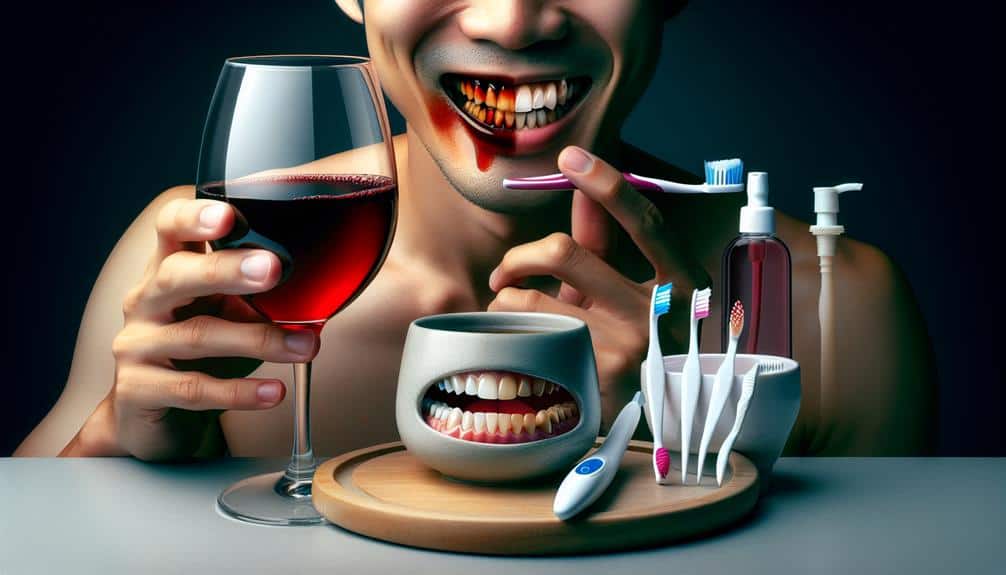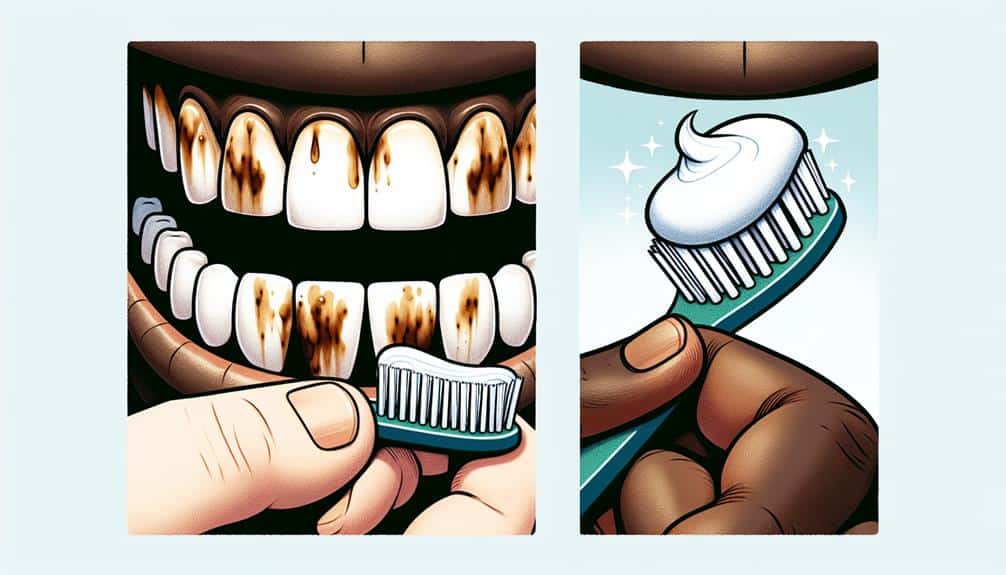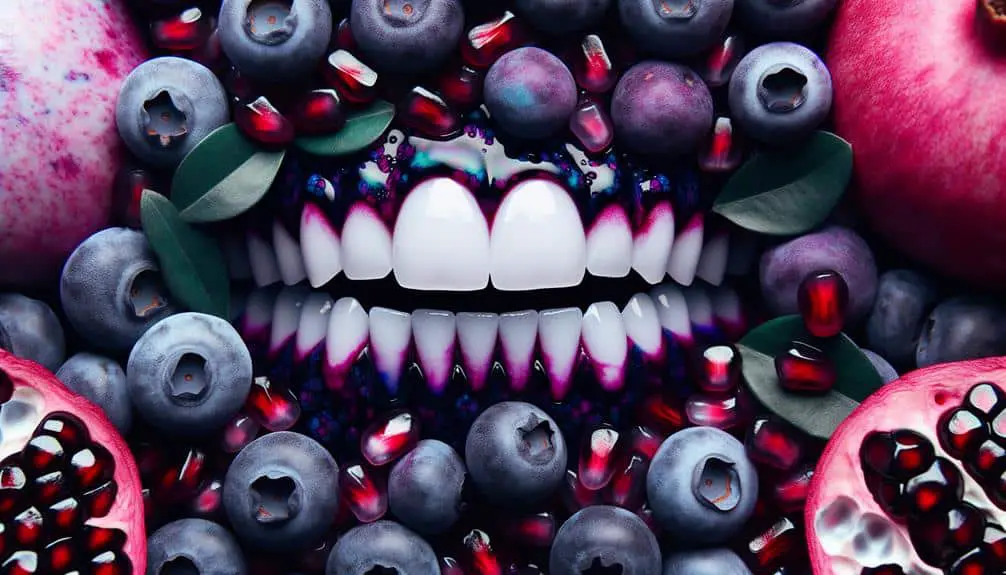To combat teeth staining from red wine and tea, focus on preventive measures to preserve your dental health and achieve a radiant smile. The pigmented nature of red wine, with chromogens, tannins, and acidity, can lead to stains on enamel, while tea's tannins and compounds like theaflavins and thearubigins can cause yellow/brown discoloration. Regular brushing, flossing, and using whitening toothpaste, along with professional dental cleanings, are essential in minimizing staining.
Consider rinsing with water after tea consumption and pairing red wine with hard cheeses to neutralize its impact on enamel. Incorporating these practices into your routine can help prevent stains and maintain oral health.
Key Points
- Rinse mouth with water after consuming red wine or tea to minimize staining effects.
- Pair red wine with hard cheeses to neutralize acids and reduce enamel impact.
- Regular brushing, flossing, and professional cleanings combat red wine and tea stains.
- Use whitening toothpaste and seek professional dental cleanings to prevent staining.
- Maintain good oral hygiene practices to prevent and combat teeth staining from red wine and tea.
Understanding Teeth Staining Basics
Understanding teeth staining basics is crucial for maintaining oral hygiene at its best. Staining of teeth can be triggered by various factors, such as consuming pigmented foods and beverages like red wine and tea, smoking, poor dental hygiene, and certain medications. When these substances come into contact with your teeth, they can result in discoloration over time.
Preventing teeth staining involves adopting good oral hygiene practices. Regular brushing and flossing help remove plaque and prevent the buildup of stains on the teeth. Using a whitening toothpaste can also assist in removing surface stains. Additionally, scheduling regular dental cleanings can help eliminate stubborn stains and keep your teeth looking bright.
Being mindful of the causes of teeth staining and taking proactive steps towards prevention can have a significant impact on the overall appearance and health of your teeth. By incorporating these preventive measures into your daily routine, you can maintain a bright and healthy smile for years to come.
Impact of Red Wine on Teeth
To fully grasp the impact of red wine on teeth, consider how this popular beverage's pigmented nature can lead to noticeable staining over time. Red wine contains chromogens, tannins, and acids that contribute to discoloration. Chromogens are deeply pigmented molecules that attach to the enamel of your teeth. Tannins, found in the skins and seeds of grapes, can also make it easier for stains to stick to your teeth. The acidity in red wine can weaken the enamel, making it more susceptible to staining.
When indulging in red wine, consider wine pairing to minimize its effects on your teeth. Pairing red wine with hard cheeses can help neutralize the acids in the wine, reducing their impact on your enamel. Additionally, maintaining good oral hygiene practices is vital in combating teeth staining from red wine. Regular brushing and flossing can help remove surface stains and prevent them from setting in. Visiting your dentist for professional cleanings can also aid in keeping your teeth free from red wine stains.
Effects of Tea on Dental Stains
Tea can contribute to dental stains due to its high level of tannins that easily adhere to your teeth, causing discoloration over time. The natural pigments in tea, known as theaflavins and thearubigins, are responsible for the staining effect. When these compounds come into contact with your enamel, they can leave behind yellow or brownish stains, affecting the aesthetic appearance of your teeth.
To combat tea stains effectively, essential dental care is necessary. Regular brushing and flossing can help prevent the build-up of stains on your teeth. Additionally, using whitening toothpaste or seeking professional dental cleaning can aid in stain removal. It's also vital to contemplate enamel protection when consuming tea. Rinsing your mouth with water after drinking tea can help minimize the staining effect by washing away some of the tannins.
Preventive Measures for Stained Teeth
To prevent the staining of your teeth, implementing proper dental hygiene practices is essential for maintaining a bright and healthy smile. Consistent care and habits can greatly reduce the risk of teeth staining caused by red wine and tea. Here are some preventive measures you can incorporate into your daily routine:
- Regular Brushing: Brush your teeth at least twice a day with a fluoride toothpaste to remove surface stains and prevent plaque buildup.
- Flossing: Make sure to floss daily to remove food particles and plaque from between your teeth, where your toothbrush may not reach.
- Routine Dental Check-ups: Visit your dentist for regular cleanings and check-ups to detect any early signs of staining and address them promptly.
In addition to these fundamental dental hygiene practices, consider incorporating home remedies and lifestyle changes into your routine to further prevent teeth staining. By being proactive and consistent in your oral care, you can maintain a radiant smile and keep teeth stains at bay.
Professional Teeth Whitening Options
Combatting teeth staining from red wine and tea can be effectively addressed through various professional teeth whitening options available to enhance the brightness of your smile. When seeking professional teeth whitening, two common avenues to explore are home whitening kits and cosmetic dentistry procedures.
Home whitening kits offer convenience and flexibility as they can be used in the comfort of your own home. These kits typically include whitening gel and customized trays that fit your teeth. Following the instructions provided with the kit can help you achieve gradual whitening results.
On the other hand, cosmetic dentistry provides a more intensive approach to teeth whitening. Procedures like professional dental bleaching or laser whitening treatments are performed in-office by dental professionals. These methods often deliver faster and more dramatic results compared to home whitening kits.
Consulting with a dental professional can help you determine the best professional teeth whitening option based on your individual needs and desired outcomes. Remember, maintaining good oral hygiene practices and regular dental check-ups are essential even after undergoing professional teeth whitening to prolong the effects and keep your smile bright.
Frequently Asked Questions
Can Natural Remedies Like Baking Soda or Hydrogen Peroxide Effectively Remove Teeth Stains Caused by Red Wine and Tea?
To whiten teeth stained by red wine and tea, natural alternatives like baking soda and hydrogen peroxide may help. However, consult your dentist for safe whitening treatments. Maintain good oral hygiene and follow prevention tips.
Are There Specific Types of Red Wine or Tea That Are Less Likely to Cause Staining on Teeth?
To prevent teeth staining from red wine and tea, opt for white wine over red, and green tea over black. Consider toothpaste with whitening properties and regular dental cleanings to combat discoloration. These choices can help maintain a brighter smile.
How Long Does It Typically Take for Teeth Stains From Red Wine and Tea to Develop?
Tooth stains from red wine and tea can develop gradually over time. Depending on individual habits, it may take a few months for noticeable discoloration to appear. Regular use of whitening toothpaste and preventive measures can help combat staining.
Are There Any Dietary Changes That Can Help Prevent Teeth Staining From These Beverages?
To prevent teeth staining from red wine and tea, consider dietary modifications like consuming crunchy fruits and vegetables that act as natural scrubbers. Brushing after consuming these beverages and maintaining good oral hygiene are key for protection.
Can Using a Straw When Drinking Red Wine or Tea Help Minimize the Risk of Teeth Staining?
Using a straw when drinking red wine or tea can help minimize the risk of teeth staining. After consuming these beverages, rinse your mouth with mouthwash to further prevent discoloration. These simple steps can maintain a brighter smile.



